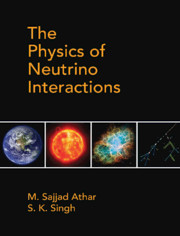Book contents
- Frontmatter
- Dedication
- Contents
- List of Figures
- List of Tables
- Preface
- Acknowledgments
- Chapter 1 Neutrino Properties and Its Interactions
- Chapter 2 Relativistic Particles and Neutrinos
- Chapter 3 Quantization of Free Particle Fields
- Chapter 4 Interacting Fields and Relativistic Perturbation Theory
- Chapter 5 Phenomenological Theory I: Nuclear β-decays and Weak Interaction of Leptons
- Chapter 6 Phenomenological Theory II: Weak Decays of Hadrons
- Chapter 7 Gauge Field Theories and Fundamental Interactions
- Chapter 8 Unified Theory of Electroweak Interactions
- Chapter 9 Neutrino and Electron Scattering from Point Particles
- Chapter 10 Neutrino scattering Cross Sections from Hadrons: Quasielastic Scattering
- Chapter 11 Neutrino Scattering from Hadrons: Inelastic Scattering (I)
- Chapter 12 Neutrino Scattering from Hadrons: Inelastic Scattering (II)
- Chapter 13 Neutrino Scattering from Hadrons: Deep Inelastic Scattering
- Chapter 14 Weak Quasielastic v(⊽)-nucleus Scattering
- Chapter 15 Inelastic Scattering of (Anti)neutrinos from Nuclei
- Chapter 16 Deep Inelastic Scattering of (Anti)neutrinos from Nuclei
- Chapter 17 Neutrino Sources and Detection of Neutrinos
- Chapter 18 Neutrino Mixing and Oscillations
- Chapter 19 Neutrino Astrophysics and the Synthesis of Elements
- Chapter 20 Neutrino Interactions Beyond the Standard Model
- Appendices
- Appendix A Lorentz Transformation and Covariance of the Dirac Equation
- Appendix B Cabibbo Theory
- Appendix C Some Properties of Pauli and Dirac Matrices and Spin Density Matrices
- Appendix D Leptonic and Hadronic Tensors
- Appendix E General Expression for the Total Scattering Cross Section and Decay Rates
- Appendix F Expressions of N(q2), the Coefficients of the Polarization Observables
- References
- Index
Chapter 17 - Neutrino Sources and Detection of Neutrinos
Published online by Cambridge University Press: 22 May 2020
- Frontmatter
- Dedication
- Contents
- List of Figures
- List of Tables
- Preface
- Acknowledgments
- Chapter 1 Neutrino Properties and Its Interactions
- Chapter 2 Relativistic Particles and Neutrinos
- Chapter 3 Quantization of Free Particle Fields
- Chapter 4 Interacting Fields and Relativistic Perturbation Theory
- Chapter 5 Phenomenological Theory I: Nuclear β-decays and Weak Interaction of Leptons
- Chapter 6 Phenomenological Theory II: Weak Decays of Hadrons
- Chapter 7 Gauge Field Theories and Fundamental Interactions
- Chapter 8 Unified Theory of Electroweak Interactions
- Chapter 9 Neutrino and Electron Scattering from Point Particles
- Chapter 10 Neutrino scattering Cross Sections from Hadrons: Quasielastic Scattering
- Chapter 11 Neutrino Scattering from Hadrons: Inelastic Scattering (I)
- Chapter 12 Neutrino Scattering from Hadrons: Inelastic Scattering (II)
- Chapter 13 Neutrino Scattering from Hadrons: Deep Inelastic Scattering
- Chapter 14 Weak Quasielastic v(⊽)-nucleus Scattering
- Chapter 15 Inelastic Scattering of (Anti)neutrinos from Nuclei
- Chapter 16 Deep Inelastic Scattering of (Anti)neutrinos from Nuclei
- Chapter 17 Neutrino Sources and Detection of Neutrinos
- Chapter 18 Neutrino Mixing and Oscillations
- Chapter 19 Neutrino Astrophysics and the Synthesis of Elements
- Chapter 20 Neutrino Interactions Beyond the Standard Model
- Appendices
- Appendix A Lorentz Transformation and Covariance of the Dirac Equation
- Appendix B Cabibbo Theory
- Appendix C Some Properties of Pauli and Dirac Matrices and Spin Density Matrices
- Appendix D Leptonic and Hadronic Tensors
- Appendix E General Expression for the Total Scattering Cross Section and Decay Rates
- Appendix F Expressions of N(q2), the Coefficients of the Polarization Observables
- References
- Index
Summary
Introduction
There are many sources of neutrinos in the universe. For example, neutrinosare produced inside the sun, the earth, and the entire atmosphere. Neutrinosare also produced during the birth, collision, and death of stars.Particularly huge flux of neutrinos is emitted during supernovae explosions.Most of the neutrinos that pass through the earth come from the sun and areproduced in the nuclear fusion reactions going on inside the sun'score. In addition, (anti)neutrinos are produced in nuclear power plants. Thebeams of high energy protons striking a target material produce intense fluxof pions and kaons, which then decay to produce neutrinos. There areneutrinos around us which were born almost 13.8 billion years ago,
soon after the birth of the universe; they constitute cosmic neutrinos (relicof the Big Bang). Neutrinos produced inside the core of the earth are calledgeoneutrinos.
Figure 17.1 represents the different sources of neutrinos. Besides thesesources, neutrinos are also produced by our body; they are also present invegetables and fruits, etc. In fact, we are living in a sea of neutrinoshaving a wide range of energies. Simply speaking, through an area of 1cm2 of our body, almost a billion neutrinos pass everysecond. The theoretically obtained energy ranges of these neutrinos arequite broad, ranging from micro electron volts for the neutrinos left overfrom the Big Bang, right up to peta electron volts for the neutrinosproduced in the violent gamma-ray bursts in the universe. Figure 17.2 showsthe predicted neutrino flux as a function of neutrino energy from a varietyof neutrino sources. Some of these neutrinos have been studied by variousneutrino experiments. In this chapter, we will discuss some of the importantneutrino sources and their detection techniques in various energyregions.
Solar Neutrinos
Production
The sun is the main source of energy for the earth. It was first suggested byEddington [884] that nuclear fusion is the source of solar energies as wellas the source of energies of other stars. However, it was Bethe [885] in1939, who explained the mechanism of thermonuclear fusion reactions, statingthat hydrogen burning takes place inside the core of the sun, in whichneutrinos are being produced, along with helium and positrons.
- Type
- Chapter
- Information
- The Physics of Neutrino Interactions , pp. 669 - 707Publisher: Cambridge University PressPrint publication year: 2020



